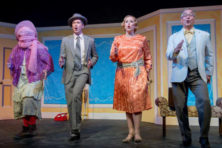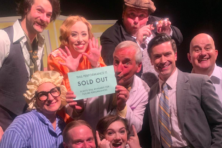Culture Club: Reclaiming a Lost Landmark: ‘La La Lucille’
- Share
- Tweet
- Pin
- Share
by Amy Frank, Managing Director, Third Avenue Playhouse
James Valcq, Third Avenue Playhouse’s co-artistic director, learned about George Gershwin at a very early age – so early that when he was 10 years old, he found a manila file folder at an antiques fair in Milwaukee that was marked “La La Lucille Selection by George Gershwin,” and he was instantly intrigued. Inside the folder he found sheet music for a lengthy, overture-like medley, including the music for six songs. Curious, he convinced his mother to buy it for him, and he’s kept it ever since. In the same manila folder.
La La Lucille was Gershwin’s first complete Broadway score, and the musical opened on Broadway in 1919. Valcq discovered more about the musical when, in 1978, Gerald Bordman’s American Musical Theatre: A Chronicle was published and provided a detailed plot synopsis. But it wasn’t until the internet era when Valcq was finally able to locate sheet music of the score’s published songs. At long last, he was able to learn the lyrics that went with the delightful melodies from that manila folder.
In 1982, a treasure trove of musical-theatre material from the golden age of theatre was discovered hidden in a warehouse in Secaucus, New Jersey. Many Gershwin shows that were thought to be lost were found virtually complete. Unfortunately, La La Lucille was not one of them. It seemed that all that remained of Gershwin’s first musical was the seven published songs, two orchestrated numbers in full score at the Library of Congress, and the complete script, containing all the lyrics, in the research archives of the New York Public Library.
Fast forward to several years ago, when Valcq realized that 2019 would be the 100th anniversary of La La Lucille’s Broadway debut. Inspiration struck, and he began to plan how to reconstruct and restore a performable version that could be produced at Third Avenue Playhouse. It was a daunting undertaking, but he was up to the challenge.
Valcq’s first task was to visit the New York Public Library, where he and Bob Boles photographed every page of the script to complete a “feasibility study” to determine its stage-worthiness. It proved to be a very funny, Feydeau-style farce. That was the easy part.
Assembling the score was another matter entirely. Valcq possessed that handful of published songs from the manila envelope, but the remainder of the music was missing and presumed lost. The photographed script provided the lyrics for the opening choruses, ensembles, “situation” numbers and finales, but there was no music. Anywhere. What to do?
Valcq, an amateur Gershwin scholar, was determined to see the project through.
“I have a fairly sturdy working knowledge of how Gershwin constructed his show scores,” Valcq said – thanks in large part to having access to numerous reconstructions done in the wake of that Secaucus find in the ’80s. “I now set myself to the task of locating every possible piece of Gershwin music published between 1917 and 1922 – the years just before and after La La Lucille.” Fortunately, all of that music is in the public domain.
The plan was to find the right music to fit all the orphan lyrics in the La La Lucille script. However, there were very few instances in which a La La Lucille lyric would graft onto a public-domain Gershwin song and make sense. Valcq found he needed to meld the melodic contour from one song with the harmonic structure from another, the accompaniment pattern from a third song and the countermelody “fill” material from a fourth – and by alchemy create a “new” Gershwin song to fit the lyrics.
Confused? Valcq has an analogy that helps to explain it: “Imagine you find a trunk filled with pieces of fabric your grandmother used to create a quilt that has since fallen apart. You decide to sew the pieces together. You don’t know what the original quilt looked like, but you take the pieces you have and stitch them together in a way that makes sense. Is it your grandmother’s quilt? No. Did your grandmother create everything that makes up the quilt? Absolutely.”
During this process, Gershwin blogger Mike Morris generously shared some of his own finds from the Library of Congress. One was the La La Lucille orchestral scores, which simply needed to be reunited with their lyrics.
Valcq recalled, “It was also through Mr. Morris that I acquired a sketch – in Gershwin’s hand! – of an unknown and unpublished melody simply labeled Nov. 29, 1921. This little gem just needed its accompaniment idiomatically filled out to provide a lilting opening to Act Two!”
To round out the remainder of the score, Valcq interspersed a number of early Gershwin songs in their entirety as a way to give a voice to some of the song-free characters and situations.
Now, two years after his centennial brainstorm (and many years after that antiques-fair find), La La Lucille will be seen and heard again – but for the first time in 100 years right here in Sturgeon Bay.
“This has truly been a labor of love,” Valcq reflected. “I hope we do George proud.”
•••
Third Avenue Playhouse presents George Gershwin’s La La Lucille July 25 through Sept. 1, Wednesdays through Saturdays, 7:30 pm; and Sundays, 2 pm. Tickets are $32 per adult and $12 per student, with a pay-what-you-can preview July 24, 7:30 pm. Purchase tickets at thirdavenueplayhouse.com or 920.743.1760.
The Peninsula Arts and Humanities Alliance, which contributes the Culture Club section throughout the summer season, is a coalition of nonprofit organizations whose purpose is to enhance, promote and advocate the arts, humanities and natural sciences in Door County.



